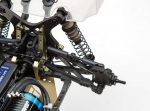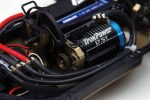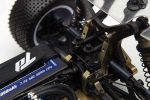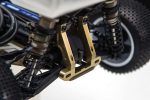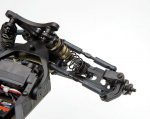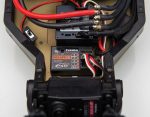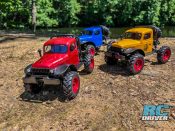Take on the Turf!
This article was originally published in RC Driver’s July 2016 issue.
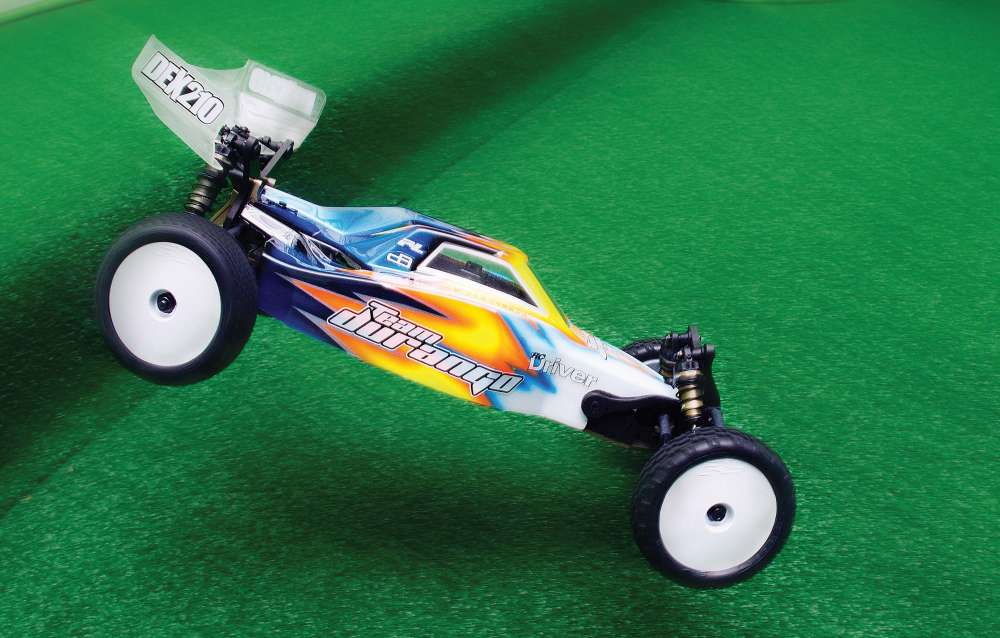
Photos: Edwin Rodriguez
The battle over what people think is RC off road racing rages on all over the internets, the Googles, “book to the face” and it’s probably deleted from many snapchats accounts every twenty four hours. Many think that dirt is the only true surface for off road and many of thosepeople use slick rubber tires on the dirt nowadays. Carpet and turf off road tracks are popping up all over the place and taking flack from dirt believers as they use spike tires to gain traction on the man made surfaces and sail over jumps. Slicks on dirt, spikes on turf… Whatever side you fall on, it’s safe to say turf and carpet are here to stay so adapt to it as you will. Turf is certainly here to stay now that manufacturers are building cars specifically for the surface and the Team Durango DEX210F seen here was built to handle the high traction hard hitting turf racing surface. The DEX210F takes many cues from Team Durango’s other vehicle offerings so we’re interested to see if this combination of machines will work well. Time to hit the track.
AT A GLANCE
WHO MAKES IT: Team Durango
WHO IT’S FOR: Intermediate to advanced driver
PART NUMBER: TD102037
HOW MUCH: $379.99
BUILD TYPE: Kit
PROS
• Shaft style low-CG driveline
• Strong aluminum chassis and rear bulkheads
• Chassis accepts saddle or shorty LiPo packs
• 12mm or 14mm wheel hex compatible
• Excellent handling and great acceleration
• Highly tunable suspension
CONS
• Shorty battery strap mount could be improved
• Lower motor mount screw requires 2mm ball hex driver
REVIEWER’S OPINION
I’m a fan of all types of racing and the emerging turf tracks piqued my interest to review Team Durango’s DEX210F turf ready buggy. The quality and tune-ability of the buggy is excellent and its low CG helps it hug the corners. If you’re going to take the green ground plunge, this turf and carpet specific platform is built for pure competition.
TOOLS AND ACCESSORIES INCLUDED
• Manual with basic setup sheet
ITEMS NEEDED
• Radio System with receiver, Steering Servo, Electronic Speed Control, Motor, Battery, Charger, Body, Paint, Pinion Gear, Wheels, Tires
ITEMS USED
• Futaba 4PX Telemetry Radio System, FUTK4905, Getting all of your race vehicles dialed into this radio is easy. It has multiple model memory, plenty of tuning functions, is easy to navigate and most importantly … comfortable when driving.
• Trakpower 50C 4000mAh Short LiPo bat- tery, TKPC0365, Trakpower has a great selec- tion of batteries for the club racer and pro racer. This short pack is well priced and pumps out plenty of power and run time.
• Futaba BLS571SV Servo, BLS571SV, This low profile servo is excellent for high speed high torque applications such as for use in EP cars, it leaves plenty of room in the front of the 210F for mounting other electronics
ADDITIONAL ITEMS USED
• dBoots NanoByte Rear A Compound Tires
• dBoots BlockPass 2WD Front A Compound Tires
• Pro-Line Velocity Wheels
• Team Associated shock and Diff oil
• Kustom RC Graphics Custom Paint
HOP-UPS WE RECOMMEND
• Team Durango Aluminum Pre-Load Nut, TD330556, One stock preload nut on our kit had a tight fit on the shock body making adjustment difficult. The precision aluminum nut makes tuning easier.
• Team Durango Spring Kits,TD230027, TD230028, TD230029, Team Durango offers a variety of spring kits to help dial your car in to track conditions. A must have for the serious racer.
• Team Durango Aluminum shock cap, TD230034, The composite shock caps work well, but there’s a chance one could get torn off in a crash. Upgrading to TD’s aluminum caps should eliminate the potential issue.
FEATURE BREAKDOWN
• If the front suspension on the 210F looks familiar, that’s because you probably saw it in last month’s 210V3 review which is a clay surface ready buggy. The front assembly features sleek shaped suspension arms to cut through the air and offer excellent durability. A thick composite tower offers several shock and camber link locations with sturdy steel turnbuckles to adjust camber. On the caster block and spindle side of the suspension, the buggy can be built for TD’s bearing in rim style set-up or a bearing in spindle set-up for 12mm rims. The rear suspension is similar in style to TD’s prior 1/10 4WD buggies with aluminum pivot blocks with adjustable inserts to support the arms. The cool factor here are the droop screws in the arms on a 1/10 machine. The droop screws will help limit the over extension of the shocks during roll in the corners and help keep the buggy flat. The shocks are large bore units with composite
caps and spring retainers. A chrome shaft slides in dual O-ring seals and standard plastic pistons control oil flow.
• A 6061 2.5mm flat aluminum plate serves as the base with composite outer rails for bracing and to mate up with the front upper brace. The nose plate is kicked up for 2WD rake and plenty of holes litter the chassis for its adjustability between a shorty pack and a side-by-side LiPo pack. The battery in either configuration is mounted with Velcro straps.
• At first glance at the F with its body off, you think you are looking at a shaft driven 4WD car, but it’s just from the center diff back. Aluminum center plates support the slipper assembly. A machined aluminum motor mount slides in and out to adjust gear mesh. Once the mount is on the chassis it is a bit difficult to get at the lower motor screw unless you have a 2mm ball hex driver. A universal driveshaft sends power to the rear gear differential. TD includes two shafts depending on how you set up the motor battery configuration. The rear diff features composite internal gears, metal bevel gears connected to the outdrives and a metal ring gear. The diff can of course be tuned with optional oils. The universal shafts to the wheel axles are Durango’s multi-axle shaft design that allows you to adjust the plunge point to alter steering response in corners. The driveline features sealed bearings too.
• Solid swinging dual bell-cranks are ball bearing supported and stuffed far up front in the buggy. The steering servo tucks in right behind the cranks and connects with a short turbuckle. Adjustable turnbuckles extend to the spindles to adjust toe.
• The body on the F is narrow up front and widens out to cover the wide mid section of the chassis. The cab is semi-forward and aero- dynamic with three slight fins at the back to control air flow. We sent our shell off to Larry at Kustom RC Graphics for some awesome paintwork. A large wing bolts to the fixed position composite rear wing mounts.
• Sorry folks, no wheels in the kit, but while building the kit, you do get to decide whether to use Durango’s 14mm wheels or the more universally accepted 12mm wheels that many other buggies use.
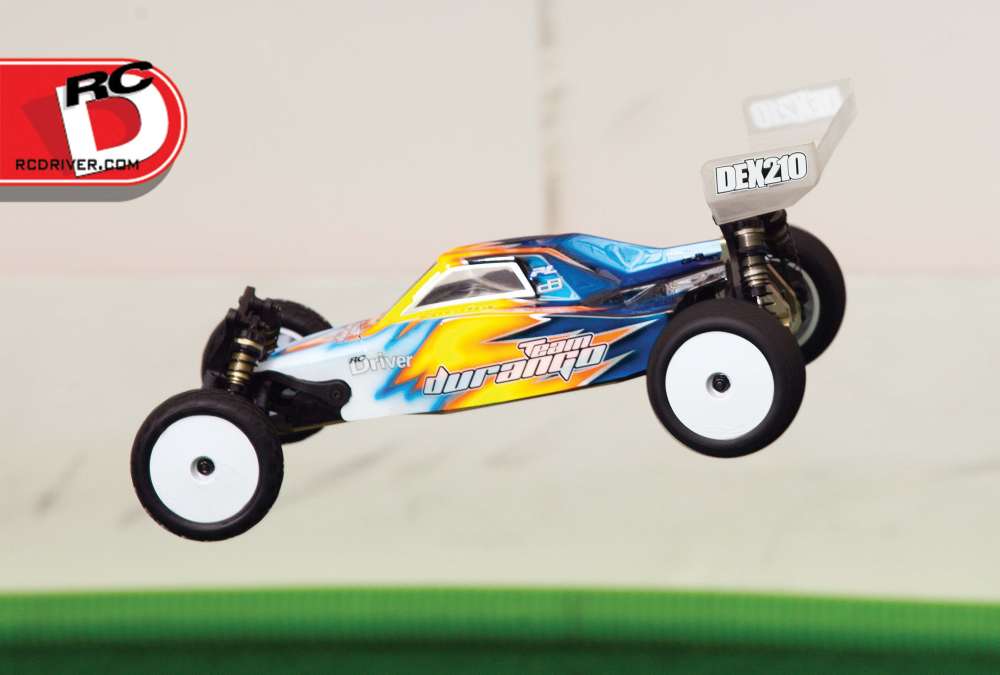
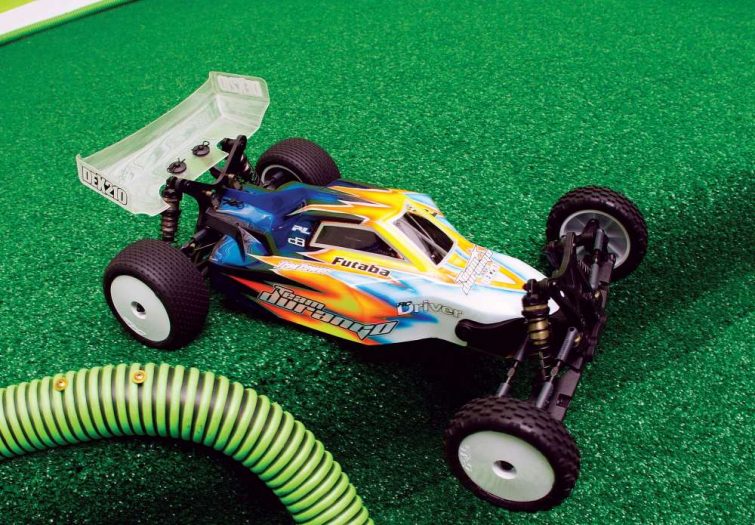
ON THE TRACK
JUMPING/HANDLING
Testing took place at a new indoor turf racing facility in New Milford, Connecticut called The Hobby Hangout. The turf is laid perfectly flat over a plywood surface and has a variety of jumps to test racers’ skill. The DEX210F was incredibly smooth over the jumps. There are several single rollers and drop-off jumps with flat landings to tackle. With flat landers, many cars will bounce on landing, but the 210F did not exhibit any nasty rebound habbits that kicked the buggy around. With turf there is very little tire scrub so when you hit a jump it’s not often easy to square up. Again the 210F was able to take off with ease, fly level through the air and even drop the nose for smooth landings on the backside of a double. Small whoop-bumps in the track were easily handled and the buggy was super responsive to wheel flicks and braking.
STEERING
The dBoots tires proved to be grippy, I narrowed up the front wheels with no inserts and there was plenty of front end bite that really helped the buggy grab going into the corners. There was a little too much front end dive that would actually cause the car to hook going in, but after the tires broke in, there was just enough scrub in the corners to reduce the harsh reaction. There is certainly no lack in steer- ing here, it’s amazing how much bite and wheel travel this car has to rip through tight corners at almost touring car speeds.
ACCELERATION/ BRAKING
The buggy was set up for stock racing and even with a 17.5T motor; the 210F has very good acceleration. Again with the grip of turf, there is almost no wheel spin resulting in plenty of bite to easily lay down the power. So no matter where you are on the track from a long straight to a short run-up to a jump the buggy easily accelerated and cleared jumps or tore down the straights. Braking is just as responsive, from controllable hard braking on the track and in the air, the buggy reacts to input to drop the nose.
DURABILITY/ EASE OF USE
Believe it or not, turf is very brutal on cars. With hard wood under the surfaces of the track and jumps as well as hard retaining walls, an awkward landing or outer wall tap can often result in a broken part, but the heavy duty arms didn’t have an issue during testing, nor the shock towers or any part on the car actually. The 210F is built well and can take some hard hits. The back of the track has a large kicker jump and it sent the 210 straight up and down right on the back wing. No damage could be seen after the hard hit, the buggy is durable. The only thing to note is some driveline noise, but it’s just the nature of the design and doesn’t impair function.
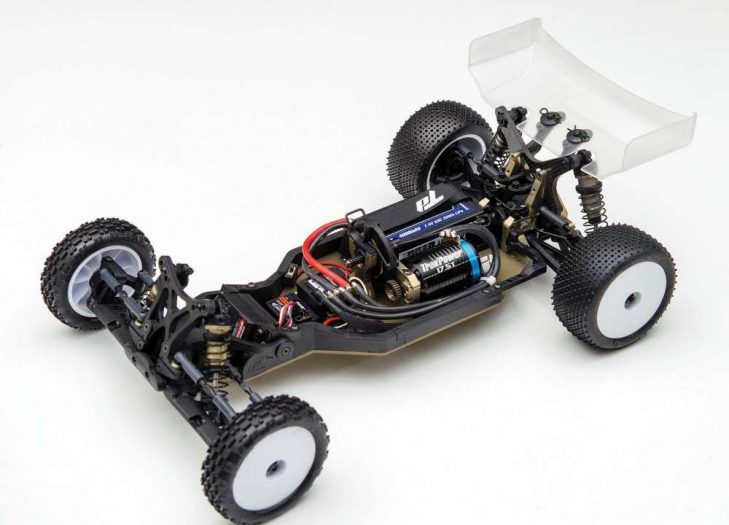
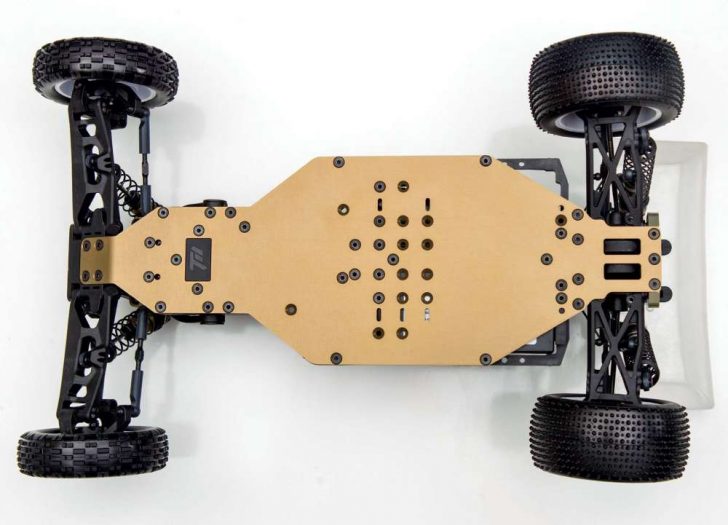
for in-depth reviews on the latest RC vehicles
SPECS AND TUNING OPTIONS
DIMENSIONS
Length: 15.8 in. (400mm)
Width: 9.8 in. (250mm)
Wheelbase: 11.2 – 11.4 in. (285 – 289mm)
Weight: 3.59 lbs (57.5 oz
BODY, WHEELS AND TIRES
Body: Clear mid cab design shell
Wheels: N/A
Wheel adapters: 12 or 14mm
Tires: N/A
SUSPENSION
Type: Front and rear double wishbone
Shock positions: F- 3 tower/ 2 arm R- 5 tower/ 3 arm
Camber: Adjustable turnbuckle
Roll: Adjustable front and rear
Wheelbase: Adjustable at rear hub and arm
Ride height: Shock Pre-load collars
Misc: Droop, optional swaybars and springs
STEERING
Type: Solid bellcrank
Toe: Adjustable turnbuckle
CHASSIS
Type: Machined plate
Material: 6061 T-6 Aluminum
Thickness: 2.5m
DRIVETRAIN
Type: 2WD
Transmission: Shaft
Differential: Oil filled gear differential
Clutch Type: Dual pad slipper
Gear Pitch: 48P
Bearings: Shielded bearing
RATING TALLY
XXXXXXX
WRAP UP
Word to the wise, don’t knock turf off-road until you try it. The surface is here to stay and therefore Team Durango has designed an excellent car with the DEX210F to handle this up and coming style of track. The F proved to be responsive, durable, easy to control and most importantly, pure fun to drive. There are plenty of tuning options on the buggy and it’s easy to work on. At the end of a full weekend of testing, I found myself planning multiple return trips to the track the following week; the buggy was that much fun to drive.
LINKS
dBoots, distributed by Great Planes Model Distributors, bestrc.com, 217-398-8970
Futaba, distributed exclusively by Hobbico, futabarc.com, 800-682-8948
Kustom RC Graphics, kustomrcgraphics.net
Pro-Line Racing, prolineracing.com, 909-849-9781
Team Durango, Distributed exclusively by Great Planes Model Distributors, gpmd.com, (217) 398-3630
TrakPower, distributed by Great Planes Model Distributors, bestrc.com, 217-398-8970
 RC Driver The Best In RC Car & Truck News, Reviews & Video
RC Driver The Best In RC Car & Truck News, Reviews & Video 


